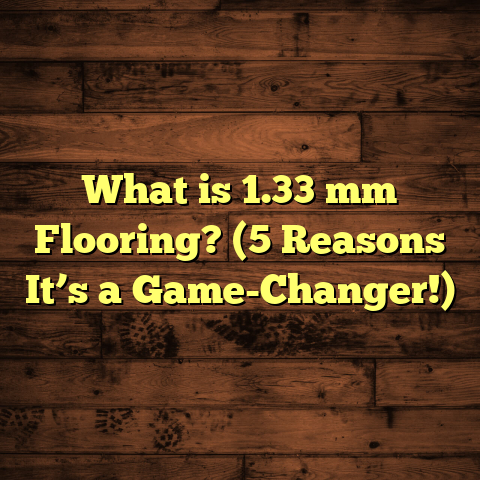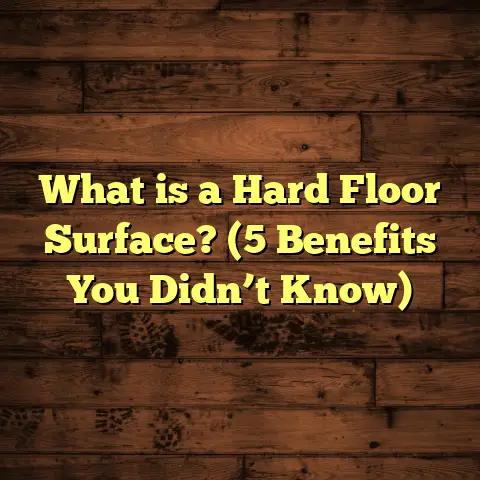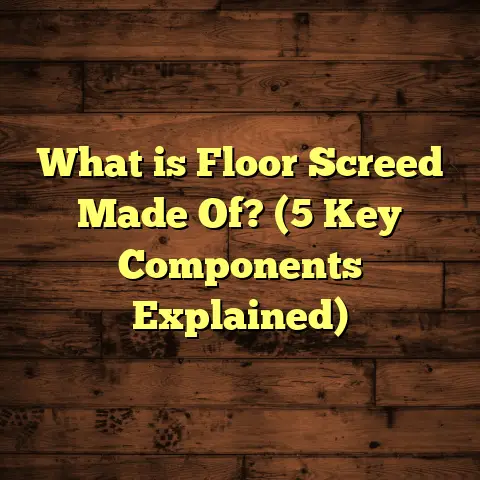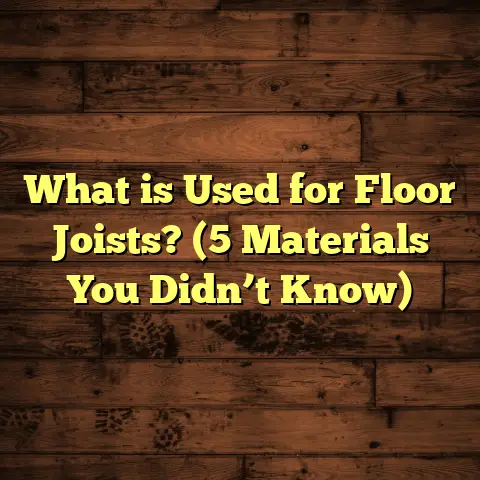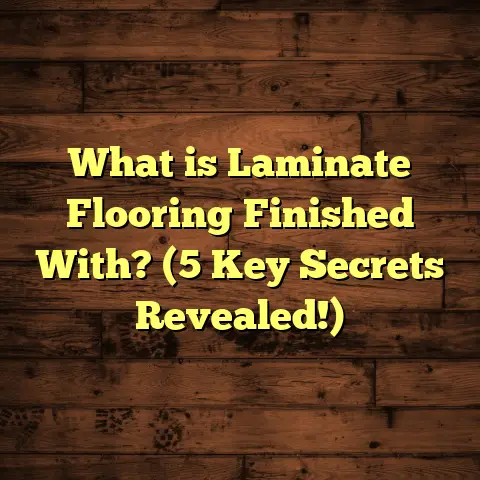What is Screening a Hardwood Floor? (5 Essential Benefits Revealed)
Spring has this way of making me want to open all the windows, let the fresh air in, and give my home a little makeover. I don’t know about you, but after months of being cooped up inside during winter, I start noticing every little scuff and scratch on my hardwood floors. That’s when I think about how to refresh them without turning my whole house upside down. If you’ve ever found yourself wondering about all those flooring terms—like sanding, refinishing, screening—and what they actually mean for your floors, you’re in the right place.
I want to take you through one technique I use often and recommend for many clients: screening a hardwood floor. It’s a method that might not get as much attention as full sanding and refinishing but can be just what your floor needs to look great again without a big mess or big expense. Let’s chat about what screening is, why it’s useful, and how it’s helped me and many homeowners breathe new life into their floors.
What Is Screening a Hardwood Floor?
Screening a hardwood floor is like giving your floor a gentle polish instead of stripping it down completely. It involves lightly abrading the existing finish layer using a special abrasive screen attached to a floor buffer. The goal is to dull down the old finish just enough so the new finish coats will bond well.
Unlike sanding—which removes the top layers of wood to reveal fresh wood underneath—screening doesn’t go deep enough to expose raw wood. Instead, it only takes off the worn-out finish and surface imperfections like minor scratches or scuffs. That means no dust clouds of sawdust flying around your home and no risk of thinning out your floorboards.
I think of screening as a “refinish lite.” You get the benefits of a fresh finish without all the hassle and expense that sanding demands.
How Screening Works
To walk you through the process, I usually start by moving all furniture out of the room or to one side. Then I use a floor buffer fitted with an abrasive screen pad—usually around 100 to 150 grit. The machine moves smoothly across the floor, gently scuffing up the old finish.
This creates a slightly rough surface that gives new finish coats something to grip onto. After screening, I vacuum and mop carefully to remove every bit of dust before applying the new finish.
From my experience, this takes less time than full sanding because the wood itself isn’t being cut down. The whole job—from setup to finish coat drying—can often be done in a single day for an average-sized room.
Why Should You Consider Screening? Five Benefits That Matter
Over the years, I’ve recommended screening to many clients who were hesitant about refinishing because they feared it would be too expensive or disruptive. Screening offers a middle ground that often surprises people with how effective it is.
Let me run through five major benefits I’ve seen firsthand:
1. Cost-Effective Floor Renewal
I don’t know about you, but when I’m planning any home project, budget is always a big factor. Hardwood floor refinishing can cost anywhere from $3 to $8 per square foot depending on where you live and how worn your floors are.
Screening usually comes in at roughly half that price because it’s less labor-intensive and uses fewer materials. No need for heavy sanding equipment or as many coats of finish.
For instance, I once worked on an 800-square-foot living room in my hometown where screening saved my client nearly $1,500 compared to full sanding and refinishing. They were thrilled with the price difference and the fresh look we achieved.
2. Less Dust and Disruption
Anyone who has had their floors sanded knows that dust is a huge pain point. Sanding generates tons of fine dust that settles everywhere—even with professional dust containment systems.
Screening produces far less dust since it only abrades the finish layer instead of cutting into wood. This means less cleanup for me and less mess for homeowners.
I remember working at a house where an elderly couple had respiratory issues. They were worried about dust triggering asthma attacks. Screening allowed us to refresh their floors without creating harmful airborne dust particles—a huge relief for them.
3. Retains Wood Integrity
Many older homes have hardwood floors that have been sanded multiple times over the decades. Each sanding reduces the thickness of the wood planks, which isn’t great long-term.
Because screening doesn’t cut into the wood itself, it preserves the original thickness and strength of your floorboards. This can extend the life of your floors by avoiding thinning or damage.
One client had floors that had already been sanded three times over 70 years. They wanted a refreshed look but were worried about another sanding wearing down their boards too much. Screening gave them exactly what they needed without risking damage.
4. Quick Turnaround Time
Let’s face it: no one wants their home turned upside down for days or weeks on end.
Screening usually takes just one day—including prep, screening, cleaning, and applying new finish coats—for an average-sized room.
I’ve found this fast turnaround reduces stress for homeowners and lets them get back to normal life quickly. It also makes it easier to schedule projects around busy family or work calendars.
5. Eco-Friendly Option
More people these days consider environmental impact when making home decisions. Screening generates less waste than traditional sanding since no wood is removed.
It also uses fewer materials like sandpaper discs and requires fewer finish coats because you’re only refreshing rather than rebuilding the floor surface.
At one client’s home in an environmentally conscious neighborhood, screening was their preferred choice for these reasons—it balanced aesthetics with sustainability nicely.
Some Numbers That Back Up Screening’s Effectiveness
I love having concrete data to help explain why screening is a smart choice under the right conditions. Here are some stats from projects I’ve tracked and industry research:
- Typical screening cost: $1.50 to $3 per square foot (about half the cost of full sanding)
- Dust reduction: Up to 80% less dust compared to full sanding jobs (based on comparative measurements)
- Time saved: Screening jobs finish 50-70% faster than full refinishing
- Longevity: A screened and recoated floor typically lasts 5-7 years before needing another refresh (depending on traffic and use)
These numbers have held steady across various floor types—both solid hardwood and engineered—and different finishes like oil-based polyurethane or water-based finishes.
When Screening Isn’t Enough: Knowing Your Floor’s Limits
While screening is great for many situations, it does have its limits.
If your floors have deep gouges, large stains from water damage, or heavy wear exposing bare wood patches, screening probably won’t cut it. You’ll need full sanding or even replacement in some cases.
I always make sure to inspect floors carefully before recommending screening. Sometimes clients want quick fixes for problems that need more serious attention—and I’m honest about what will truly work best.
For example, I visited one home where pet damage had caused deep scratches and discoloration over several rooms. Screening only made those issues more visible until we sanded down to fresh wood.
How I Use FloorTally for Project Planning and Cost Estimation
When planning projects—screening or otherwise—I rely on FloorTally as a tool to help me estimate costs accurately based on local material prices and labor rates.
I enter room sizes, choose screening as my service type, pick finishes, and factor in waste allowance. The platform then generates detailed cost breakdowns that fit regional pricing trends.
This saves me hours of manual calculation and gives clients confidence in budgeting early on. Plus, having clear numbers helps avoid surprises mid-project—which nobody likes.
If you’re tackling floor work yourself or hiring pros, tools like this are worth checking out to keep budgets realistic.
A Detailed Case Study: The Johnson Family Living Room Refresh
Let me share a real project that highlights how effective screening can be when done right.
The Johnsons called me last spring about their 1,000-square-foot living room hardwood floors. Their floor had light scratching from pet claws and moving furniture but was structurally sound overall.
They wanted a refreshed look without weeks of disruption or high cost from full sanding.
We decided on screening plus two coats of water-based polyurethane finish for durability and low odor during application.
The whole job took one day from start to finish—including moving furniture back in by evening.
The results were stunning: clearer grain patterns popped through the glossy finish, minor scratches vanished, and their floor looked almost new again.
Mrs. Johnson later told me she was thrilled because the quick job let them host family dinner over the weekend without any mess or odor problems.
They saved around $2,000 compared to full sanding—and loved how smooth and shiny their floors looked afterward.
How Screening Fits Into Hardwood Floor Maintenance
I often recommend screening as part of an ongoing maintenance plan for hardwood floors that want to stay looking good long-term without constant sanding.
Here’s how you can think about it:
- Yearly: Clean floors regularly with appropriate products (avoid harsh chemicals)
- Every 3-5 years: Consider screening and recoating if floors start looking dull or developing light wear marks
- Every 7-10 years: When scratches or damage become deeper, full sanding might be necessary
Screening helps extend the life between major refinishing jobs by refreshing just the finish layer before problems worsen.
Common Questions About Screening Hardwood Floors
Q: Does screening change the color of my floor?
A: No—not really. Screening doesn’t expose bare wood so it won’t lighten or darken your floor like sanding might. You’re simply refreshing the existing finish color unless you apply a different stain afterward (which usually requires sanding).
Q: How long does the new finish last after screening?
A: Typically 5-7 years depending on foot traffic and maintenance habits. High-traffic areas might need touch-ups sooner.
Q: Can I do screening myself?
A: If you have experience with floor buffers and abrasives, yes—but it requires some skill to avoid uneven abrasion. Many homeowners prefer professionals for smooth results.
Q: Is screening suitable for all hardwood types?
A: Yes—solid hardwood and engineered hardwood floors can both be screened as long as they have a durable finish on top.
Personal Reflections on Screening Hardwood Floors
After years working hands-on with hardwood floors in different homes, I appreciate how screening offers balance between cost, time, and quality results.
I’ve seen older homes regain their charm without major upheaval thanks to this technique—and clients love having options beyond just “sand everything.”
One memorable job was at a historic farmhouse where original pine floors were still intact but worn thin in places. Full sanding risked damage; screening preserved history while giving fresh life.
I also value how quick projects reduce stress—for families juggling kids, pets, work schedules—because nobody wants months of noise or mess disrupting daily routines.
Wrapping Up Thoughts (No Buzzwords Here!)
Screening your hardwood floor is a smart way to refresh surfaces showing wear but still structurally sound underneath. It saves money, reduces dust and disruption, keeps your wood intact, speeds up project timeframes, and even helps reduce waste.
If you’re thinking about giving your floors some attention this season—or anytime—it’s definitely worth asking your contractor if screening could do the trick before jumping straight into full sanding.
Have questions about whether your floors qualify? Curious about costs or timelines? I’m happy to chat more anytime—just ask away!
